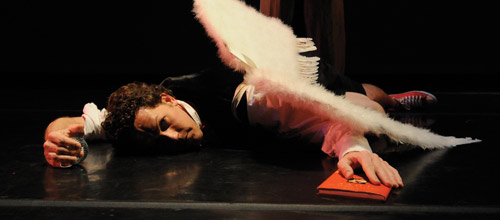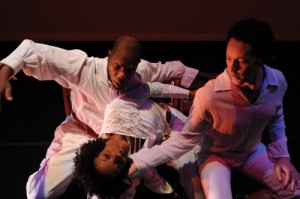Nomadic Choreographer Gives His Work an Address

Does jhon r. stronks make dances that aren’t “about” anything?
by Neil Ellis Orts • Photos by r salant
As the son of an airline pilot, jhon r. stronks moved around. A lot. Before college, he attended 13 different schools. Much of that time was in California, where he still spends a good portion of his time, but his nomadic youth has made the transition into nomadic dancer/choreographer more natural. These days, he’s presenting work in San Diego, Los Angeles, Memphis, Houston, and Atlanta.
The longest he’s ever stayed in one place was the six years he spent in Atlanta with CORE Performance Company (formerly Several Dances CORE). This spring, stronks returns to Atlanta, where he is collaborating with CORE’s artistic director Sue Schroeder on a new dance, The Moment Between. CORE, which also maintains a Houston base, will premiere this work with Schroeder’s The Point at Barnevelder Movement/Arts Complex, March 11–12.
Here, stronks talks about his history and his inspiration and the importance of behaving.

Neil Ellis Orts: When did you start dancing?
Jhon r. stronks: I started training formally when I was a senior in high school. I took a dance class for a P.E. credit. They quickly decided I should do more, so they sent me to the ballet school, where I danced with three- and four-year-olds.
My mom says I started dancing when I was two. Apparently my favorite song was “Sweet Gypsy Rose.” Every time it came on in the grocery store, no matter what, I would start dancing and people would gather around. The more people gathered around, the more I danced.
Most of high school, I was a choir nerd, and I thought I was going to be a voice major. Then I went through my first jury, and I had to stand up in front of the music faculty and let them know what key I’d be singing my chromatic scale in, sing some other things I’ve blocked out, and then sing my selections. As soon as that was over, I went down the hall to the dance department and changed my major. I was never going to go through that again. [Both laugh]
Where was this?
This was at California State University at Fresno. I started taking everything at once. I was doing studio dance classes and I was dancing at school during the day. I was taking jazz, ballet, modern, hip-hop, choreography—once I found it and people told me I could do it and I was good at it and it also felt good, I was all over it.
When did you start choreographing?
I started choreographing pretty much as soon as I started dancing. The program at Fresno State had a big emphasis on creation. The reason we were all there was to make dances and express ourselves, so we just started making dances. It was so much fun, and you didn’t have to do it by yourself, but you could still be an individual. There were all these different ways of displaying behavior. You could go out there and behave without having to act, without having to speak. Funny that I now do so much talking in my dances, but there was a time when the thing that really inspired me was the fact that there was no talking, it was just behaving. The behavior of the body, it’s really happening right there in front of you, it’s really behaving. Or not behaving. [Both laugh]
Or misbehaving.
I’ve often been told that my dances are misbehaving, but that’s fine.
Let’s talk about your work. I’ve seen a range of stuff, but do you see recurring themes?
I’m still trying to figure out what my work is about. Because to me, the word “about” has this really superficial feeling to me. It’s “about,” it’s not really, but it’s “about” this thing, it’s around it.
It’s dancing around the subject.
Yeah, I don’t want to dance around the subject. I want to give it an address and say, “This is where it is and if you want to deal with it, we can go there together and have a conversation. Or not. But this is where it is, and you can come or you can go, but just give it an address. Let’s address it. This is where it lives—all correspondence can be forwarded to this address.”
I was raised by a woman who made it known that there are certain things that have happened in this world, and we have to stand up and make sure that we don’t do those things again, and everyone must be treated with respect. So I grew up thinking that I have to not get involved in sexism and racism, and call these things out. In our transient lifestyle, I ended up living close to or right smack dab in the middle of African-American communities. I grew up with a lot of African-American friends. I grew up not thinking much about being the only white person in a black room.
So for a long time my work had that as a theme. I was trying to figure out why I was identifying with this thing that I’m now being told is specifically African-American history. So I started to go back and look at what the difference is between the black movement and the African-American movement. I started to realize that I didn’t necessarily agree or identify with some of what was going on there. Some of it began to look a little too much like what I was told wasn’t right.
So I started looking at behavior, and how that behavior then contributes to how things get done or don’t get done, and to how much gets done. For a while my work was addressing the gap between what started with the civil rights movement and what ended up getting done.
I see it happening in the gay community. I see a huge difference between what it means to be gay and what it means to be queer. But to me, it’s the same behavior. Now I feel like my focus is more on that gap between queer politics and gay politics and what are we doing and why we are dividing.
So is all this squirming around seen in the work you’re making for the CORE show?
I feel like at the core of all this stuff that I go into and talk about with my dancers—the politics and racism and sexism—the reason I’m addressing this is that I’m concerned with my own healing. I feel like if I don’t heal, then I can’t be helpful to other people. If we’re going to get together and put this much effort into it, then I want it to be an authentic learning experience so you can get something livable out of it.
I want the whole experience to be something that people can enjoy. That doesn’t necessarily mean it’s a happy thing and we’re going to be smiley the whole time, but that something actually happens—[without] so much tension around it that nobody opens up to actually let it happen.
What I love most about making dance is that it’s labor. We go out in front of people and we do something.
What: CORE Performance Company presents The Moment Between and The Point
When: 8 p.m., March 11–12
Where: Barnevelder Movement/Arts Complex, 2201 Preston at Hutchins
Tickets: $20
More info: coredance.org, 713/862-5530, or thereinthesunlight.com (stronks).
Neil Ellis Orts is a frequent contributor to OutSmart magazine.










